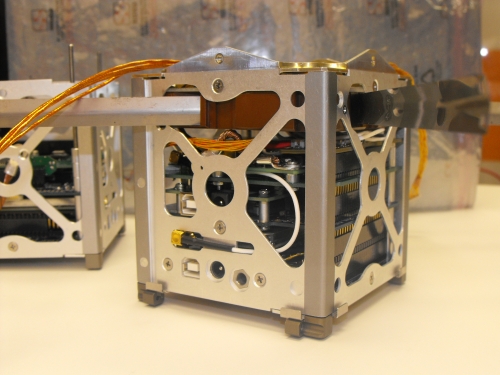Wow.. 1 lagi satelik amator yang telah dilancarkan pada 8th of Dec 2010 jam 1400-1722 GMT.
The satellite would be transmitting beacon data in the Amateur Band, with the following specifications.
Call Sign: KJ6FIX
Downlink Frequency: 437.600 MHz
Beacon Output Power: 900mW
Modulation Type: AFSK, 1200 baud
TLE: Updated on website, right after launch.
Sila emailkan Telemetry data yang anda terima dari satellite ini kepada: caerus@astronautics.usc.edu

Berikut adalah maklumat lanjut tentang satellite ini:
Hello Sir/Madam,
I would like to announce the expected launch of University of Southern California's (USC) CAERUS aboard the SpaceX Falcon 9 rocket, on the 8th of Dec 2010, with a launch window of 1400-1722 GMT.
CAERUS is USC's 1st CubeSat subsystem delivered in May 2010, and was named after the greek word for "opportunity". It was developed from authorization to proceed (ATP) to delivery in 14 weeks. CAERUS is part of the "MAYFLOWER" Next Generation Technology CubeSat that is a joint effort with Northrop Grumman NOVAWORKS group.

The satellite would be transmitting beacon data in the Amateur Band, with the following specifications.
Call Sign: KJ6FIX
Downlink Frequency: 437.600 MHz
Beacon Output Power: 900mW
Modulation Type: AFSK, 1200 baud
TLE: Updated on website, right after launch.
It would be greatly appreciated, if you can please collect the beacon data and email the raw text file to caerus@astronautics.usc.edu. The collection of the data would help USC in tabulating the performance of our first student driven endeavour into space.
For further information and TLE updates, please go to the website http://www2.isi.edu/research/prj-ser...projects-9.htm. The beacon data can also be translated with the jar applet provided on our website.
Thanks for all your help,
Regards,
USC CubeSAT Team.
## P.S. ##
- If it's raw beacon data file, please have your email subject: Beacon Data and your info.
- If you have the capability of hooking up a Spectrum Analyzer to the antenna feed, and can measure the 'Actual' frequency of the downlink, please send that too, with the Subject: Beacon Frequency. This is very important to us, for a tracking experiment we are conducting.

Key Characteristics:
- "1U" form factor structural integration of two complete RF subsystems, with 2 separate micro-processors (PIC24's)
- Fully qualified in Thermal Vacuum and 3-Axis Vibration
- New Antenna Module validated in the UltraLab RF Chamber on USC Campus
- Burn in with over 100 hours for Flight Software and Telemetry Systems
- Integration of 3 new Technologies (new Quad monopole deployable antenna, an RF splitter, and burn wire mechanism)
- Built and integrated by professionals and students at SERC

General Information: CAERUS was USC's 1st satellite subsystem put into space. It is a "1U Cubesat" that fits with a 2U Cubesat to make up a complete 3U when launched.
Launch and Initial Orbit Information: Caerus Successfully launhced on the SpaceX Falcon 9 at 10:43 EST from Cape Canaveral FL. The TLE is below:
F9_cubesat
1 99999U 99999 10342.68664352 .00000000 00000-0 00000-0 0 14
2 99999 34.5382 180.5256 0019992 245.8787 334.0535 15.92118320 16
Communication Systems Information: CAERUS uses amateur satellite band. The following information is required to recieve information from the CAERUS satellite:
- CALL SIGN: KJ6FIX
- Beacon Downlink Frequency: 437.600 MHZ, 25kHz bandwidth
- Beacon Output Power: 900mW
- Antenna: Quad Monopole
- Modulation Type: AFSK, 1200bps
- Modulation Frequency: Approximately every 10 seconds a beacon pulse is sent, except over the Ground station at USC (Los Angeles CA).

Data Analysis Information: Go to following link for the telemetry protocol for both analyzing the information packets, and for a small JAVA script that will automatically decode it for you.CAERUS Telemetry Data & QSL Card
Please send any/all information packets recieved (raw only) to the following e-mail address with the word "Pass" in the title of the e-mail: caerus@astronautics.usc.edu
Example:
USC CAERUS Received Frequencies Report
- Station Name: USC
- Station City, State, Country: Los Angeles, CA, U.S.A.
- Latitude: 34.0194º
- Longitude: -118.287º
- Elevation: 100 meters
- Frequency Measurement Equipment Brand Name and Model #: TBD
- Equipment measurement-noise (if known): TBD
| Beacon # | Received Frequency (MHz) | Time Received (GMT or 24hr local time identified)(hh:mm:ss) |
|---|---|---|
| 1 | 437.009924 | 03:15:23 |
| 2 | 437.0097884 | 03:15:27 |
| 3 | 437.009615 | 03:15:35 |
| 4 | 437.0093903 | 03:15:40 |
| 5 | 437.0090947 | 03:15:46 |
| 6 | --- |


2 comments:
Masih tidak dapat detect satelik ini dengan menggunakan element yg diberikan. Maklumatnya di amsat dot org pun masih belum ada
dah hantar email pada dia org tanya pasal element.. tapi tak dijawap pun.. nampak gayanyer baik aku delete aje post ni... buang masa aje
Post a Comment